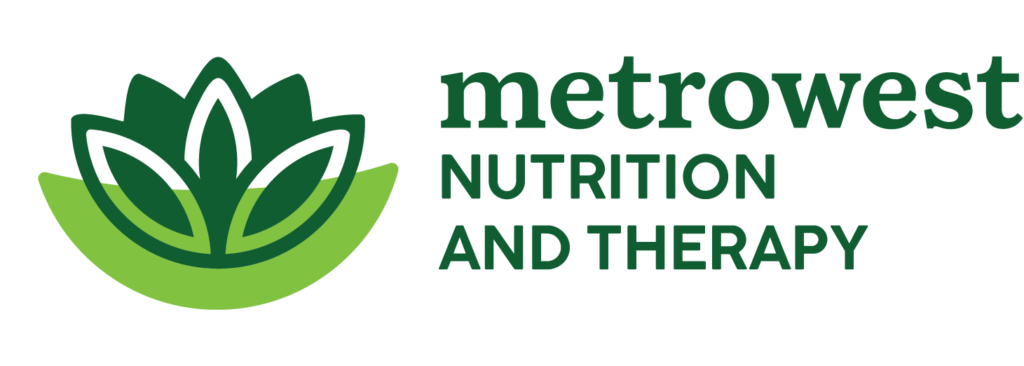
The Nutritionist’s Role in Eating Disorder Treatment
February 25th through March 3rd is National Eating Disorder Awareness Week. We’d like to take this opportunity to talk about what our work with eating
disorder patients looks like. Successful treatment of eating disorders involves a multi-disciplinary approach. Members of the treatment
team include a physician, a psychotherapist, a psychiatrist, a registered dietitian/nutritionist and at times family therapist. Here, we’ll give
you a glimpse at what the nutrition therapy component of eating disorder treatment may look like.
What is Nutrition Therapy?
Nutrition Therapy is an essential component of eating disorder treatment. Provided by a registered dietitian or nutritionist, nutrition therapy includes
a combination of nutrition education, meal planning, cognitive behavioral therapy and goal setting. It also may include hands-on exposure and skills
work. Nutrition therapy helps the individual recovering from an eating disorder cultivate a healthier relationship with food and gain skills needed
to feed oneself. As part of the mutli-disciplinary team approach, the nutrition element of treatment focuses food-related behaviors allowing time in
psychotherapy to be spent focusing on the underlying issues.
Not surprisingly, nutrition therapy is met with a great deal of resistance. In the nutritionist’s office, patients face their fear head on.Imagine you are
deathly afraid of snakes and suddenly find yourself in a cobra den and you’ll get a sense of what it’s like for an individual with an eating disorders
to sit in a nutritionist’s office. However difficult it may be, sitting with this fear (in a safe environment) is an important part of recovery.
What is a Registered Dietitian/Nutritionist?
The dietitian or nutritionist works as an integral part of the multi-disciplinary team. This person has extensive knowlege on food, nutrition and metabolism. In
addition to providing counseling and education, he or she will help the team determine a healthy weight goal, energy needs, risk of malnutrition and
strategies for behavioral change.
Many people wonder what the difference is between a dietitian and a nutritionist. Here is the short and simple answer. A registered dietitian (RD) is credentialed
through the Academy of Nutrition and Dietetics, whereas no credentialing is required to call oneself a nutritionist. Many dietitians will refer to themselves
“nutritionists” or “nutrition therapists” but you want to look for the letters “RD” after their name to make sure you are getting your information
from a credible source. You can learn more about the credentialing process here. Most states have
a licensing board for nutritionists and dietitians. Anyone can gain a license to work as a Licensed Dietitian or Nutritionist (LDN) by paying a fee
and in some cases, passing a qualifying exam.
It is important for the nutritionist on the team to have prior eating disorder experience and/or receive close supervision from someone who has. Most dietetic
programs do not offer training in eating disorders beyond class review. Here are some important questions to ask a dietitian:
- Have you ever worked with eating disorders? If so for how long?
- What is your philosophy, approach, etc.?
- Do you collaborate with other clinicians? If so, how have you done so in the past?
- Where do you get support around eating disorder cases you work with?
What Can I Expect at the Nutritionist’s Office?
Naturally, people struggling with eating disorders feel nervous about going to see a dietitian or nutritionist. It might be helpful to know a little about
what to expect. Here are some things a nutritionist is likely to address at the first few visits:
- What you hope to get out of nutrition therapy
- Prior experience working with a nutritionist/dietitian
- Your concerns around eating/health
- Your medical history
- Family medical history
- Medications and over-the-counter supplements
- Your weight history (note: some of this can be obtained from your doctor)
- Your diet history
- Diet recall (i.e. you may be asked to verbally recall what you’ve eaten)
- Diet history (i.e. past diets, nutritional issues, allergies, etc.)
- Review of eating disorder behaviors
- Review of physical symptoms
- Lifestyle (work, school, relationship, etc)
- What motivates you in your recovery
Most individuals arrive at the nutritionists’s office with a lot of knowledge. While this information may be benign or even helpful to the average person,
when filtered through the lens of an eating disorder, it can be detrimental. This is a growing concern in the information era as we are bombarded with
endless statistics on obesity and related dietary recommendations.
The nutritionist will reframe distorted thoughts about food and the body to help shape and strengthen the patient’s healthy voice. Many patients carry the
dietitians’ words with them. They will replay them in challenging situations or when urges to use disordered eating behaviors arise. Over time, the
hope is for patients to internalize these messages.
What is a meal plan?
A meal plan is a tool often used in eating disorder recovery that provides a framework for normal eating. The nutritionist will formulate a meal plan catered
to the patient’s individual nutritional needs. A dietitians may use the exchange system for this purpose. The exchange system includes food portion
estimates or “exchanges” from each food group (i.e. grains, proteins, fruit, vegetables, milk/dairy, fats, sweets). These exchanges are used to map
out a balanced, varied eating plan.
The meal plan provides structure and an external guideline for patients with eating disorders. It is helpful to have this external framework initially
since most people with eating disorder lose the ability to recognize physical hunger cues. Eating mechanically by way of the meal plan provides the
foundation for internal food regulation. Think of the meal plan like the “training wheels”. A person won’t need it forever, but in the initial stages
of treatment it is very helpful.
What are other strategies used in nutrition therapy?
Through a thorough assessment of a person’s history and goals, the nutritionist will determine what strategies will be most helpful. Here are some
examples of work an eating disorder patient might do in the nutritionist’s office:
1. Nutrition Education and Counseling
A large part of nutrition therapy includes education and behavioral counseling. Nutritionists specializing in eating disorders encourage healthy eating
while emphasizing the importance of pleasure and moderation in the eating process. Individuals with eating disorders hold a lot of distorted thoughts
about food and their bodies.The dietitian helps challenge and reframe these thoughts while providing accurate and helpful information on nutrition
and metabolism to support the recovery process.
2. Motivational Work and Support
Since most patients arrive at treatment with a high level of ambivalence, the nutritionist will often do some motivational counseling to help move them
towards change.It is important that the patient be invested in the work but a certain degree of uncertainty and fear is normal.A good dietitian or
nutritionist will determine what motivates their patients and help support them through difficult changes.
3. Exposure and Skills Work
The dietitian will often coordinate with the psychotherapist and/or other members of the team to learn strategies for helping the patient relax during
this type of work.
- Plan when challenging foods will be incorporated
- Strategize around how to manage challenging food situations
- Try challenging foods in session
- Visit the grocery store
- Eat at a restaurant
4. Mindfulness/ Appetite Awareness Training
Once a patient is ready, it’s beneficial for them to move towards internal regulation of food intake.In order to provide the skills needed for this, the
nutritionist or dietitian will do some mindful eating and appetite awareness training.Here are some activities that may be used to enhance this part
of the recovery process:
- Keeping food journal and rating hunger and fullness levels
- Mindful eating exercises in session
- Providing guided meditation opportunities and/or tools
This is a snapshot of what eating disorder nutrition therapy may look like with the relationship between nutrition therapist and client being a central
and important component. Please feel free to reach out if you have any questions or would like to discuss nutrition therapy for eating disorders
further info@metrowestnutrition.com.



